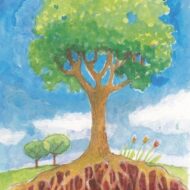I am reading an article by Evan Thompson, Empathy and Consciousness, found in the Journal of Consciousness Studies. A few passages have gripped my curiosity and invited my attention to wander off with their content:
“According to John Morgan Allman (1999), it was the formation of the extended family as a social support structure for the nurturing of slowly developing offspring that drove the evolution of large brains in apes and humans: ‘the development of the brain to the level of complexity we enjoy– and that makes our lives so rich– depended on the establishment of the human family as a social and reproductive unit’ (Allman, 1999, p.2).”
Inquiries that continue to surface in circles in which I participate are: What is the evolutionary edge of social systems? How are we evolving? How do we effectively and consciously engage in collective leadership?
And the phrase that keeps resurfacing for me in response to these questions: A collective consciously birthing itself for the greatest good.
Circling back to Thompson and Allman’s thoughts, I think about the deliberate and intentional attention and energy being channeled into the establishment of collective groups as conscious and creative social and reproductive units. The immediate human family and its reproductive capacities are extending to include increasingly conscious local and global collaborates of individuals and groups connected to one another through expanding means of technology and communication. As I see it, as we are returning to and embracing the wisdom of villages and tribes that depend upon one another for survival, integrating that wisdom, and becoming conscious of its place in connecting fragmented and isolated configurations of communities and groups. (Obviously my words are brief and leaving out a lot here… feel free to fill in any holes that are screaming at you!)
From my perspective, the success of collectives coming to consciously birth their experience is completely contingent upon the strength of interpersonal and relational bonds within the system. Just as an individual’s awareness of their own subjectivity is directly correlated with the depth and span of their influence for good, so also is the collective’s to the degree it commits itself to a practice of awareness of its own intersubjective dynamic. Becoming “self-aware” as a collective necessitates first coming to know one another – coming into comfort and expertise in the vulnerable terrain of authentically showing up with one another, and exploring the unknown and uncharted pathways of our intersubjectivity.
Returning to Thompson:
The intersubjective openness of consciousness and empathy are the preconditions for our experience of inhabiting a common, intersubjective, spatial world. Empathy… provides a viewpoint in which one’s centre of orientation becomes one among others…
And Thompson quotes Dan Zahavi as saying:
“Even if consciousness could turn its attention so completely toward itself that everything else were excluded, it would not escape the confrontation with Otherness”(Zahavi, 1999, p.125).
As I conclude this exercise in wandering through the forest of curiosity and intellectual language, the yearning that remains with me finds expression in these closing words:
that gives rise to expanding expressions of togetherness and oneness.
